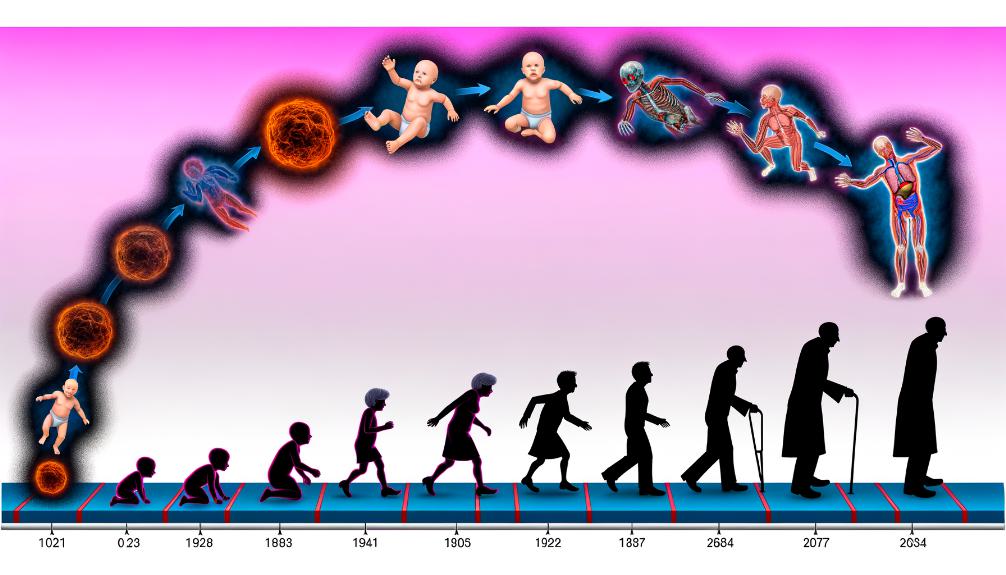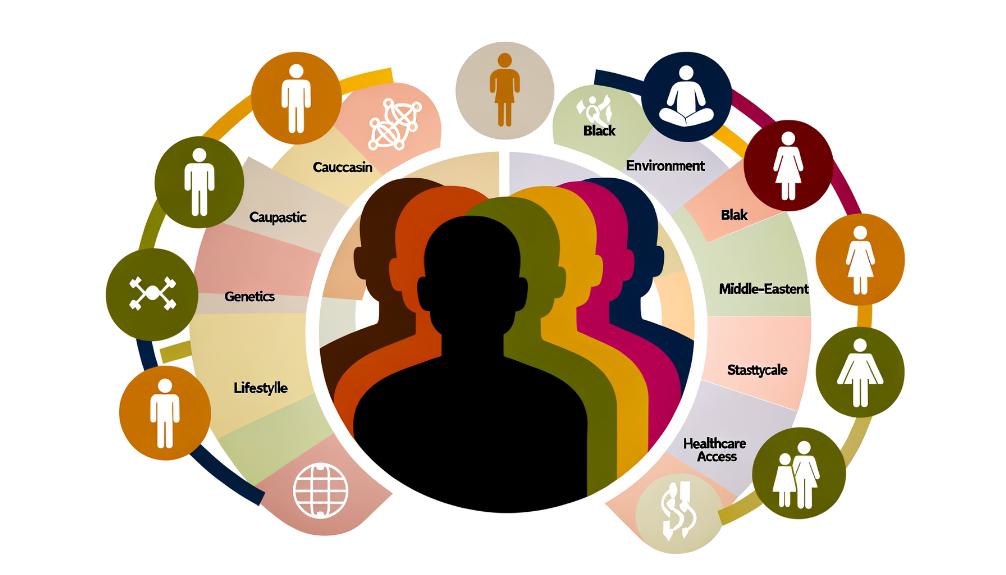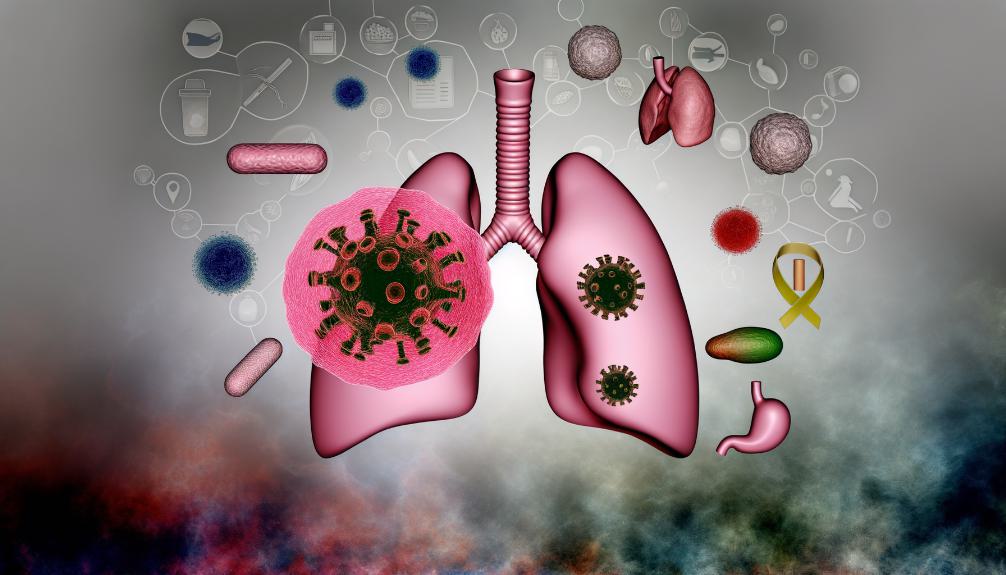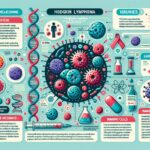Non-Hodgkin Lymphoma Risk Factors Beyond AFFF
We're closely examining non-Hodgkin lymphoma (NHL) risk factors beyond just exposure to Aqueous Film Forming Foam. It's key to recognize that age, sex, and ethnicity play important roles in NHL risk. Older adults, men, and certain ethnic groups face higher susceptibility. Moreover, a family history of NHL, exposure to harmful chemicals, radiation, and having a weakened immune system or autoimmune diseases greatly elevate risk levels. Infections and lifestyle choices, including body weight and the use of textured breast implants, also influence the likelihood of developing NHL. By grasping these varied factors, we empower ourselves with knowledge for better prevention and management. This understanding leads to informed decisions and potential prevention strategies.

Key Takeaways
- Exposure to chemicals like benzene and certain pesticides can elevate the risk of developing Non-Hodgkin Lymphoma.
- A weakened immune system, due to conditions like HIV or organ transplants, significantly increases NHL risk.
- Family history plays a role, with increased risk if a first-degree relative has been diagnosed with NHL.
- Certain infections, including specific viruses and bacteria, are linked to an elevated risk of developing specific types of lymphoma.
- Autoimmune diseases such as rheumatoid arthritis and Sjögren syndrome are associated with a higher risk of NHL.
Age and NHL Risk

As we age, our risk of developing non-Hodgkin lymphoma (NHL) markedly increases, especially once we hit our 60s and 70s. It's a sobering fact that age stands as a significant risk factor for NHL, with a majority of diagnoses occurring in individuals who are 60 or older. This trend isn't just a statistical anomaly; it's a clear indicator that as we advance in years, the likelihood of facing this challenge escalates.
Understanding this correlation between age and NHL risk is essential not only for early detection but also for formulating appropriate management strategies. It's known that older adults are more susceptible to common subtypes of NHL, which suggests that the disease doesn't just become more likely with age but may also manifest in forms that are more challenging to treat. This increased vulnerability can be partly attributed to age-related changes in the immune system. As we get older, our body's defenses become less robust, less capable of fending off diseases, including the malignant cells responsible for NHL.
Recognizing the role age plays in NHL risk underscores the importance of vigilant health monitoring as we age. It's a reminder that our immune system's decline isn't just about catching colds more easily; it's about an increased risk for serious conditions like non-Hodgkin lymphoma. As we navigate our later years, being aware of this risk factor allows us to be more proactive about our health, seeking early intervention and employing strategies that might mitigate the risk, even if only slightly. In the context of NHL, knowledge of how age influences risk can be a vital tool in our health management arsenal.
Sex Prevalence
Turning our attention to the aspect of sex prevalence, we've observed that non-Hodgkin lymphoma exhibits a notable gender disparity. It's more common in men than women, a trend supported by various studies highlighting the higher incidence rates among the male population. This raises intriguing questions about the underlying factors contributing to this difference, which we'll explore further in our discussion.
Gender Differences Examined
Exploring the gender differences in Non-Hodgkin lymphoma (NHL) reveals that men are markedly more susceptible to developing this condition than women. This disparity isn't just a statistical anomaly but highlights an essential aspect of NHL's sex prevalence. The fact that men are more likely to be diagnosed with NHL compared to women underscores the influence of gender on NHL risk factors. Studies suggest this higher incidence in men may be due to a combination of biological influence and environmental exposures, indicating that gender-specific factors play a pivotal role in NHL's development. This understanding stresses the importance of considering gender in tailoring screening and prevention strategies, as well as in the research and management of NHL, to effectively address these disparities.
Male Vs Female Statistics
We've observed that Non-Hodgkin lymphoma (NHL) is slightly more common in men than in women, with a male-to-female diagnosis ratio of about 1.5:1. This indicates that men are at a higher risk of developing this type of cancer compared to women. The factors behind this gender disparity in NHL risk are still being studied, but it's evident that men face a higher risk of NHL. Understanding these statistics is vital in guiding healthcare providers to tailor screening and prevention strategies effectively. By acknowledging the sex prevalence in NHL, we can better support people in managing their risk factors for lymphoma, particularly for men who are more likely to be diagnosed with this disease.
Ethnicity Variations

We're turning our attention to the significant role that ethnicity variations play in the incidence of non-Hodgkin lymphoma. It's clear from the data that ethnic prevalence differences exist, suggesting that genetic risk factors and socioeconomic impacts contribute uniquely across various groups. By focusing on these disparities, we can better understand how to develop targeted prevention and screening strategies for those most at risk.
Ethnic Prevalence Differences
In examining the risk of non-Hodgkin lymphoma, it's clear that ethnicity plays a substantial role in the prevalence of this disease across different groups. Studies have shown that White individuals in the US are more likely to develop this condition compared to African Americans and Asian Americans. This highlights the impact of ethnic disparities on disease risk, suggesting that both genetic and environmental factors unique to specific ethnicities contribute significantly. By understanding these ethnic prevalence differences, we're better positioned to tailor prevention strategies and healthcare interventions for at-risk populations. Additionally, research into these variations underscores the importance of including diverse populations in the study of non-Hodgkin lymphoma incidence, aiming to reduce the disparities and improve outcomes for all affected individuals.
Genetic Risk Factors
Understanding the genetic risk factors for non-Hodgkin lymphoma reveals that ethnicity variations have a notable influence on susceptibility to this disease. We've learned that a genetic predisposition plays a key role in the non-Hodgkin lymphoma risk, with ethnicity playing a critical role in these genetic factors. Specifically, white individuals in the US face a higher risk compared to African Americans and Asian Americans. This highlights different genetic susceptibilities among ethnic groups. By delving into how these variations impact genetic risk factors, we can better tailor prevention and treatment strategies. It's important to recognize these differences, as they underscore the complex interplay between genetics and ethnicity in determining non-Hodgkin lymphoma risk, guiding us towards more personalized healthcare approaches.
Socioeconomic Impact
Exploring how ethnicity variations influence socioeconomic impacts reveals significant disparities in non-Hodgkin lymphoma outcomes. We've observed that ethnicity and socioeconomic factors play an important role in these disparities, particularly in access to healthcare. For instance, white individuals in the US are more likely to develop non-Hodgkin lymphoma compared to African Americans and Asian Americans, highlighting a need for tailored prevention and screening strategies across racial groups. In addition, the incidence of non-Hodgkin lymphoma is significantly higher in white populations in developed countries, underscoring the intersection of ethnicity, socioeconomic status, and health outcomes. It's clear that addressing these disparities requires a focused approach on improving access to healthcare and devising racial group-specific prevention and screening strategies to mitigate non-Hodgkin lymphoma rates effectively.
Family History Impact

We're delving into how a family history of non-Hodgkin lymphoma can increase your risk of developing the disease. Understanding the role of genetic predisposition due to family history is essential in evaluating individual risk factors. Research has shown that having a first-degree relative with non-Hodgkin lymphoma slightly increases the chances of being diagnosed with the condition. This connection underscores the importance of genetic factors in the disease's development.
It's been established that the impact of family history on non-Hodgkin lymphoma risk isn't consistent across the board. The specific subtype of lymphoma and the genetic complexities involved play a significant role in determining risk levels. Consequently, individuals with a family history of lymphoma are encouraged to undergo genetic counseling. This step is crucial in understanding their unique risk factors and preparing for any necessary preventive measures.
Despite the significance of family history as a risk factor, it's important to note that many non-Hodgkin lymphoma cases occur in individuals without any familial link to the disease. This observation highlights the complex interplay of genetic and environmental factors in the development of non-Hodgkin lymphoma.
Chemical Exposures
While the genetic landscape greatly influences non-Hodgkin lymphoma risk, it's important to also consider the role of environmental factors, such as chemical exposures, in its development. Research has consistently shown that exposure to certain chemicals, including benzene and various herbicides, is linked to an increased risk of non-Hodgkin lymphoma. These substances, often found in agricultural and industrial settings, can penetrate our lives through occupational exposure or even through residues on food products.
Moreover, it's not just industrial chemicals that raise concern. Specific chemotherapy drugs and medications prescribed for rheumatoid arthritis have also been associated with a heightened risk of developing this type of cancer. These findings suggest that while these treatments are important for managing certain health conditions, there could be unintended consequences that need careful consideration and monitoring.
In addition to these, our environments play a significant role. Environmental and occupational exposure to petrochemicals and pesticides is another area of concern. These substances, prevalent in many modern industries, have been identified as potential risk factors for non-Hodgkin lymphoma. The widespread use of pesticides in agriculture and pest control further increases the likelihood of exposure, emphasizing the importance of understanding and minimizing such chemical exposures.
Understanding the role of these chemical exposures in the development of non-Hodgkin lymphoma is vital. By identifying and mitigating these risks, we can work towards reducing the incidence of this disease. It's clear that while we can't change our genetic makeup, there are steps we can take to minimize our exposure to harmful chemicals, thereby potentially reducing our risk of developing non-Hodgkin lymphoma.
Radiation Effects

We're now turning our focus to the impact of radiation as a significant risk factor for non-Hodgkin lymphoma. It's important to understand the various types of radiation exposure, the biological effects radiation can have on our bodies, and the preventive measures we can take to mitigate these risks. This discussion aims to arm us with knowledge essential for reducing our chances of developing this condition.
Types of Radiation Exposure
Understanding the various types of radiation exposure is key to grasping how they contribute to the increased risk of non-Hodgkin lymphoma. Radiation exposure, emerging from sources like atomic bombs, nuclear accidents, and medical radiation therapy, is closely linked to this risk. These incidents release ionizing radiation, known for its capacity to cause DNA damage. This damage is a pivotal factor in the development of non-Hodgkin lymphoma, as it disrupts normal cell growth and function. Studies underscore that individuals subjected to high levels of ionizing radiation may face a heightened likelihood of developing certain subtypes of this disease. It's important to recognize the impact of different sources of radiation exposure in evaluating non-Hodgkin lymphoma risk factors, making informed prevention and treatment strategies paramount.
Radiations Biological Impact
Building on our knowledge of radiation exposure sources, let's examine how this impacts our bodies and contributes to non-Hodgkin lymphoma development. When we're exposed to high doses of ionizing radiation, from atomic bombs, nuclear accidents, or medical radiation therapy, it can cause significant DNA damage. This damage leads to genetic mutations, potentially contributing to the development of various subtypes of non-Hodgkin lymphoma. Specifically, individuals exposed to radiation, especially at a young age, face an increased risk. These radiation-induced lymphomas present unique characteristics and treatment challenges, differentiating them from other types. Understanding the biological impact of radiation on the lymphatic system is crucial in evaluating risk factors and mechanisms potentially leading to non-Hodgkin lymphoma, emphasizing the need for heightened awareness and preventive strategies against radiation exposure.
Preventive Measures
To lessen the risk of non-Hodgkin lymphoma from radiation exposure, it's essential to adopt preventive strategies and measures. We must acknowledge that ionizing radiation is a significant factor in increasing lymphoma risk. As a result, individuals who've been exposed should undergo regular screenings and diligent follow-up care. This approach is not just about early detection; it's about understanding the unique characteristics and treatment considerations that radiation-induced lymphomas might present. Additionally, a thorough individual risk assessment, considering the specific history of radiation exposure, is essential. By taking these steps, we're not just reacting to potential threats but proactively working to reduce the impact of radiation exposure on lymphoma risk.
Immune System Weakness

When it comes to non-Hodgkin lymphoma, a weakened immune system greatly increases an individual's risk of developing this type of cancer. This vulnerability can be attributed to various factors, including organ transplants, HIV infection, and the use of immunosuppressive medications. Individuals who have undergone organ transplants or are HIV-infected face a significantly higher risk due to their compromised immune responses. These conditions create an environment where abnormal lymphocytes, which are a hallmark of non-Hodgkin lymphoma, can proliferate unchecked.
Moreover, the administration of immunosuppressive medications post-organ transplant is a double-edged sword. While these drugs are essential in preventing organ rejection, they also suppress the immune system's ability to fight off cancers, including non-Hodgkin lymphoma. This juxtaposition highlights the critical balance needed in managing organ transplant recipients' health, ensuring the benefits of immunosuppression do not inadvertently elevate the risk of developing cancer.
It's important for us to understand these dynamics as they play a significant role in evaluating the risk profile for non-Hodgkin lymphoma in individuals with compromised immunity. By acknowledging the impact of immune system weakness, be it from organ transplants, HIV infection, or the use of specific medications, we can better strategize prevention and early detection efforts. This knowledge not only aids healthcare professionals in providing tailored care but also empowers patients through informed decision-making regarding their treatment options and lifestyle choices.
Autoimmune Disease Links
Exploring the connection between autoimmune diseases and non-Hodgkin lymphoma reveals a critical link in understanding this cancer's risk factors. Autoimmune conditions like rheumatoid arthritis and Sjögren syndrome are not just debilitating on their own; they also heighten the likelihood of developing non-Hodgkin lymphoma. This association underscores the complex interplay between the immune system's dysfunction inherent in these diseases and the onset of specific cancer subtypes.
We've learned that individuals grappling with autoimmune diseases face an increased risk of encountering particular forms of non-Hodgkin lymphoma. The immune system, designed to protect us, malfunctions in these conditions, potentially contributing to cancer development. This connection isn't just a footnote in medical textbooks; it's a significant focus of current research. The emphasis is on the importance of vigilantly monitoring and managing autoimmune conditions to mitigate this risk.
Understanding how autoimmune diseases propel the risk for non-Hodgkin lymphoma is pivotal. It not only illuminates potential pathways for cancer's emergence but also highlights the necessity for early detection and the formulation of personalized treatment strategies. By acknowledging the increased risk posed by autoimmune conditions, we can tailor our approach to prevention, ensuring a more targeted and effective response for those affected. This insight is invaluable, offering a glimmer of hope for individuals dealing with the complexities of both autoimmune diseases and non-Hodgkin lymphoma.
Infection Types

Beyond the realm of autoimmune disorders, certain infections also play a vital role in escalating non-Hodgkin lymphoma risk. We've come to understand that infections like the Epstein-Barr virus, Hepatitis C virus, and Helicobacter pylori are intricately linked to specific types of non-Hodgkin lymphoma. Additionally, bacterial infections, including Chlamydia psittaci and Campylobacter jejuni, may also increase the risk of developing certain subtypes of this lymphoma.
These infections are more than just common health nuisances; they can profoundly impact the immune system and even the DNA of lymphocytes. This alteration in the lymphocyte's functionality and genetic makeup can potentially lead to the development of non-Hodgkin lymphoma. It is important to highlight that the risk factors associated with infection-related lymphoma vary by subtype. This underscores the complex interplay between different infections and the development of lymphoma, emphasizing the importance of understanding these connections for targeted prevention and treatment strategies.
In our efforts to combat non-Hodgkin lymphoma, acknowledging the role of infections is essential. The Epstein-Barr virus, Helicobacter pylori, Chlamydia psittaci, and Campylobacter jejuni, among others, are not mere infections but potential gateways to a significantly increased risk of lymphoma. As we explore further into the study of these infections, our goal remains clear: to develop strategies that not only treat but also prevent the onset of non-Hodgkin lymphoma, thereby safeguarding the immune system and overall health of those at risk.
Body Weight Concerns
Several studies have indicated that carrying excess body weight may greatly increase one's risk of developing non-Hodgkin lymphoma (NHL). It's imperative that we comprehend that being overweight or obese doesn't just impact our physical appearance but also has significant implications for our health, including an increased NHL risk. This connection between higher body weight and NHL suggests that our lifestyle choices, particularly related to diet and exercise, could be pivotal in managing this risk.
It's recognized that excess body weight can negatively affect immune function and promote inflammation, two factors that are believed to contribute to the development of NHL. This relationship underscores the importance of maintaining a healthy weight through balanced diet and regular physical activity. By prioritizing our health in this way, we're not only addressing NHL risk but also enhancing our overall well-being.
Discussing weight management strategies with healthcare providers is another step we can take to lessen the NHL risk. Professionals can offer personalized advice and support, helping to navigate the challenges of achieving and maintaining a healthy body weight. It's about creating a sustainable approach that includes nutritious food choices and an active lifestyle.
Breast Implant Questions

We're now turning our attention to the concerning link between textured breast implants and an increased risk of developing breast implant-associated anaplastic large cell lymphoma (BIA-ALCL). It's become increasingly clear that women with textured implants are at a critical lymphoma risk, a reality that's prompted the FDA to issue safety alerts and step up monitoring. BIA-ALCL isn't just any lymphoma; it's a rare type of T-cell lymphoma closely linked to these specific breast implants.
The association between textured implants and BIA-ALCL has led to significant concern. Symptoms like swelling, pain, and fluid accumulation around the implant site should prompt immediate consultation with a healthcare provider. It's vital for those with breast implants, especially textured ones, to be vigilant about monitoring their health and report any unusual symptoms as soon as they're noticed.
In response, the FDA's safety alerts have been a critical step in raising awareness among both the public and healthcare professionals. These alerts highlight the importance of recognizing potential symptoms early and seeking prompt medical advice. Diagnosis and treatment typically involve removing the implants and the necessary intervention to address the lymphoma.
Our collective understanding of the risks associated with breast implants, particularly textured ones, has evolved. Ongoing research and monitoring are essential to assure the safety of individuals who have or are considering breast implants. The connection between breast implants and BIA-ALCL underscores the need for informed decision-making and awareness of potential health implications.

This post has been generated by AI and was not reviewed by editors. This is Not legal advice. Please consult with an attorney.




